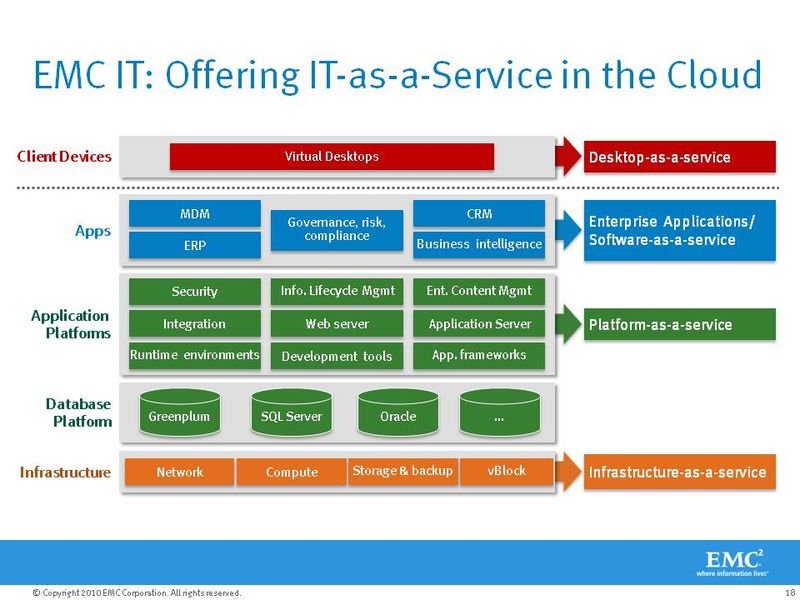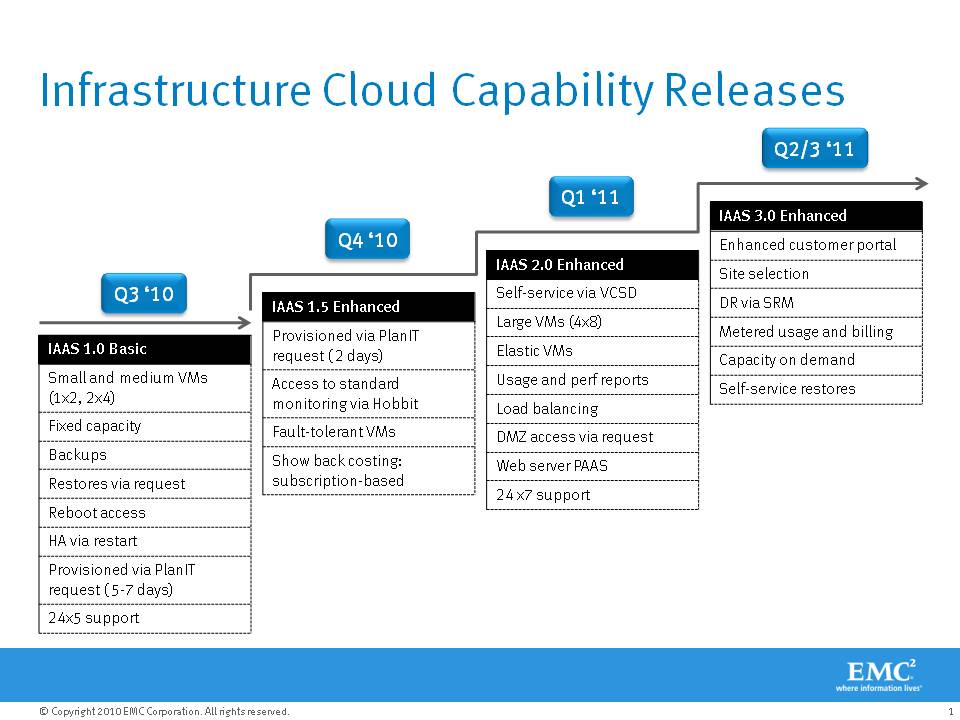Ok, so Chuck beat us to it – he liberated our EMC IT slides here and they are all out and creating a buzz by themselves. A more elaborate explanation is needed on some of the content, so here goes for a start in outlining our thinking before I dive into details in future posts.
As Chuck called out, one of the key objectives in our journey to the Private Cloud is IT-as-a-service. IT-as-a-service starts with a focus on the customer (our own internal business units). What does that mean ? It means ensuring that we within IT can provide (i) the agility that is demanded by the business, (ii) at the desired quality of service, (iii) with the appropriate security, risk and compliance considerations, and of course (iv) at the right cost model. It also goes to the heart of customer satisfaction – the model of IT being the sole provider of services is long gone even as different SaaS and cloud offerings have enhanced what the customer can avail of. So our vision and goal for IT-as-a-service is to optimize both the IT delivery and business consumption of services and be the service provider of choice.
What does this mean for us as an IT organization ?
 It means that we have to get more efficient at what we do to provide the required agility, but also package our offerings into consumable services – with explicit service level objectives and guarantees, and the means to entitle and measure the usage of the services. ITIL, anyone ? The notion of service management and ITIL emerged more in the datacenter and infrastructure space, but the requirements for IT-as-a-service have come up at all levels in the picture alongside – for infrastructure (IaaS) , programmable platforms (PaaS) , configurable applications (SaaS), and for desktops and devices (DaaS?) too.
It means that we have to get more efficient at what we do to provide the required agility, but also package our offerings into consumable services – with explicit service level objectives and guarantees, and the means to entitle and measure the usage of the services. ITIL, anyone ? The notion of service management and ITIL emerged more in the datacenter and infrastructure space, but the requirements for IT-as-a-service have come up at all levels in the picture alongside – for infrastructure (IaaS) , programmable platforms (PaaS) , configurable applications (SaaS), and for desktops and devices (DaaS?) too.
The ultimate vision for IT-as-a-service is for the business customer to be able to (a) get on a self-service portal (b) pull up the available IT services from a service catalog, (c) choose the level of service required, (d) provision the services requested, (e) as necessary, combine them for increased business value using business process and service tools, and (f) start using the services. The entitlement and metering infrastructure will, behind the scenes, regulate the usage of the services and also provide a charge-back (or show-back) mechanism as part of the usage. Furthermore, the cloud offers the promise that these services are being rendered in a location-agnostic manner i.e. based on the SLAs requested, what the customer wanted done could be in a local data center or in a remote data center, basically anywhere in the cloud.
So, are we there yet ?
 Not quite. In EMC IT, we are on the verge of establishing the technology underpinnings for the super-vision painted above. The other part of the ‘Not quite’ answer above is in establishing jointly with the customer, a mechanism to dialog and govern what is being requested.
Not quite. In EMC IT, we are on the verge of establishing the technology underpinnings for the super-vision painted above. The other part of the ‘Not quite’ answer above is in establishing jointly with the customer, a mechanism to dialog and govern what is being requested.
So what about the tech stuff ? As discussed in my previous post, we are definitely close to it on the IaaS front (see slide alongside) where standard compute, storage, network-level resources can be provisioned in an automated way and then made available to the customer. We have also done a lot of work already on the PaaS/SaaS fronts too but the integration of those services into a service catalog and into a self-service portal are further away. For instance, if you consider database-as-a-service, we have already consolidated several database instances and support an Oracle grid, a SQL server grid and a Greenplum-based horizontally scalable platform. Today, we can provide slices of these platforms on an per-ask basis and in a mostly-fully automated manner. We still need to integrate the availability of slices of these platforms into a seamless self-service offering. That is not far away.
You may ask – what do you have to talk to the customer about ? Would they not have told you exactly what they want through the self-service portal ?
Not quite again. We are early on in this journey and the nature of what can be provisioned from a low touch model will still be mostly generic. But we know it is all about setting expectations. It is important to make sure that what the customer expects from the requested service is what they get. Furthermore, it is also important to make sure that from an enterprise perspective, the customer will use the service appropriately. For instance, it is up to the enterprise to make sure that information is protected appropriately from a risk, compliance and regulatory perspectives. Sometimes, the customer may not be aware of all the implications of asking for zero data loss or for a certain level of performance. Hence, we need to have the accompanying dialog with the customer and a policy/governance model for how the services can be used. It goes without saying that the speed implied by provisioning through a self-service portal cannot be dampened by a long discovery and dialog process. So we have to get more fluid and streamlined to make some of those decisions with shorter and shorter timeframes.
Again, you may ask – if you are going to slow down the process with all the dialog and discovery anyway, why even provide the impression that it can be self-service ?
We look at this as an opportunity to improve the agility and efficiency of our internal IT processes in steps. Recent technology (such as to provision all the layers of the stack in a convergent fashion) has advanced the capabilities of the ecosystem so customers can help themselves. However, we in IT may not unveil the self-service portal initially to the customer but instead leverage it within IT to fulfill a request made by the customer through a regular existing channel. Once we have a more mature model of what all the services are, how they can be appropriately requested, and how efficiently they can be fulfilled, we can then share the self-service portal to the customers.
Another important element that cannot be ignored in this mix of ‘long poles’ is the approval process for expenditures. Financial controllers will still need to approve the purchase of the services with accompanying business cases, so some of those processes will need to be rationalized and optimized as well to balance the speed of ‘swipe a credit card’ expectations.
I think there is enough to think about at this stage. Our vision is clearly along the lines of unshackling the customer by making the capabilities available, but we need to ensure the capabilities do not cause enterprise problems along the way. Hence the guarded way of approaching this.
And of course, I need fill in the detail of what else we are doing on the parts of the ITaaS stack. A lot more to come on this …